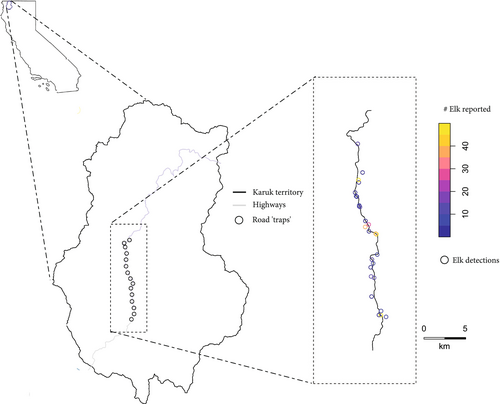
New Study from DSE and the Karuk Wildlife Team Combines Citizen Science and Local Indigenous Knowledge in Novel Approach to Biodiversity Monitoring
DSE and the Karuk Wildlife Team are thrilled to share new research in Ecology and Evolution that validates the importance of implementing local Indigenous knowledge in studies on biodiversity and population changes over time. Our paper provides groundbreaking analysis on how the Wildlife Team’s traditional knowledge, research, and citizen-science efforts support elk restoration and presents a potential model for Indigenous-led conservation efforts worldwide. It was co-written by DSE team members, the Karuk Wildlife Team, and former postdoctoral researchers in the UC Berkeley Department of Environmental Science, Policy, and Management.
Modeling Community Reports of Elk Sightings and Traditional Knowledge
 In this paper, we developed population estimates of Roosevelt elk (Cervus canadensis, Karuk: Ishyuux) in Karuk Ancestral Territory in northern California through the 2020-2021 winter. Because it is a culturally and ecologically significant species, the Karuk Wildlife Team has organized a 7+ year-long community elk sighting program. We wanted to evaluate whether the elk population density could be inferred from this data source, grounded in Karuk traditional ecological knowledge (TEK). We found that the population density estimates obtained were comparable to those produced from other data sources (scat collection & camera trapping) in the same region.
In this paper, we developed population estimates of Roosevelt elk (Cervus canadensis, Karuk: Ishyuux) in Karuk Ancestral Territory in northern California through the 2020-2021 winter. Because it is a culturally and ecologically significant species, the Karuk Wildlife Team has organized a 7+ year-long community elk sighting program. We wanted to evaluate whether the elk population density could be inferred from this data source, grounded in Karuk traditional ecological knowledge (TEK). We found that the population density estimates obtained were comparable to those produced from other data sources (scat collection & camera trapping) in the same region.
To generate population estimates, we engaged closely with Karuk Wildlife Team, which liaised between the academic research team and the broader Tribal community. The project was grounded in Karuk Tribal research protocols and oversight processes, and methods were designed in full collaboration with the Karuk community.
The Karuk Wildlife Team amassed elk counts from the community (including direct sightings, counts along identified routes, etc.), and incorporated Karuk TEK on elk behavior, seasonal movements, and habitat usage. We then used a Bayesian modeling framework to incorporate sightings and concurrent GPS monitoring data to estimate population density and compared these results to population estimates derived from a camera trap study in the same area.

Community-Driven Population Estimates Reflect Expected Densities
We found that combining community-derived wildlife counts and Karuk TEK produced robust elk population estimates, and revealed a model for how to improve estimates of animal populations more broadly. More specifically:
- Community reports and Indigenous knowledge of elk produced robust estimates of population density when compared to expected ranges and more traditional scientific methods (camera trapping).
- Intimate local knowledge of landscapes can fill gaps that conventional surveying may face, particularly where resources, terrain, or access limit Western scientific monitoring approaches. In general, this knowledge can take advantage of generations of intimate, place-based knowledge and should augment, inform, validate, or extend traditional scientific study.
- Karuk cultural and ecological insights improved monitoring results through their interpretations of seasonal patterns, habitat use, movement corridors, etc.
- Tribally- and locally-driven data collection, when combined with modern detection and survey methods, can support more sustainable management of Tribal lands and wildlife populations.
We are proud to put forth a model for how biodiversity monitoring can be more culturally‑relevant, community‑engaged, and resilient (especially when facing resource constraints and in the midst of massive biodiversity loss). We want to highlight the importance of close collaboration with the Karuk Wildlife team, which enabled the broader Tribal community to trust that the research was being conducted in their best interests, and that the data was being collected, stored, analyzed, and stewarded safely by the Karuk Wildlife Team.
Co-Design is Fundamental to Advancing Science
Together with the Karuk Wildlife Team, we see “co-design” as a fundamentally necessary approach to scientific research. Co-design refers to processes in which Tribal communities are equal partners with non-Tribal groups in developing and implementing science, so that methods and solutions are culturally relevant and honor traditional knowledge. As part of our ongoing collaboration with the Wildlife Team, we develop tools and studies that demonstrate the inherent and practical benefits of co-design for advancing data and environmental science. Read more about our work here.
Future Research and Acknowledgements
Important caveats include that community reports may still face detection bias (i.e. when sightings are obscured by terrain). Further, Indigenous knowledge varies widely across communities and places. In the future, we recommend studies with a longer time series, or replication of this study in other Indigenous territories.
This research project came to be as part of a larger, ongoing collaboration with the Karuk Wildlife Team, researchers, and collaborators that are working with Indigenous biodiversity monitoring data from the Wildlife Team.
We appreciate those who contribute to community reports, and we're grateful to the entire research team behind this work:
- Emilio Tripp, Karuk Wildlife Team
- Daniel Sarna-Wojcicki, Karuk Wildlife Team
- Ben. J. Saxon, Karuk Wildlife Team
- Jessica Camarena, Karuk Wildlife Team
- Mike Polmateer, Contributor to Community Reports
- Thomas Connor, Assistant Professor at Trinity College Dublin and former postdoc in the Department of Environmental Science, Policy, and Management
- Felipe Montealegre-Mora, former DSE postdoc
- Magali de Bruyn, DSE Data Scientist and Research Software Engineer
- Kendall Calhoun, postdoc at UCLA & UC Davis
- Ciera Martinez, DSE Senior Program Manager

